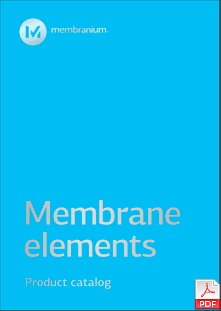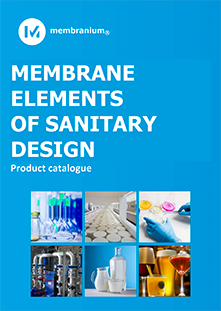“Membranium” spiral-wound ultrafiltration membrane elements in sanitary design are a proven and obvious choice for a variety of processes. The main tasks of ultrafiltration membrane elements are purification, fractionation and concentration, as well as purification of products.
"Membranium" spiral-wound ultrafiltration membrane elements are used to solve many different engineering problems, for example:
-
Production of protein preparations from plant and animal raw materials;
The use of ultrafiltration makes it possible to obtain high-margin protein products that neutralize protein deficiency due to the consumption of foods with an insufficient amount of protein.
-
Production of enzymes, gelatin, glycerin, pectin, clarification of syrups;
The gelatin solution obtained as a result of the extraction is preliminarily purified from impurities and fat. Then ultrafiltration is carried out, in which condensed gelatin is obtained in the concentrate. As a result, the quality of the gelatin is maintained with low energy consumption.
-
Obtaining high-viscosity products.
When working with highly viscous products (cottage cheese, Greek yogurt), membrane elements with a large spacer thickness (up to 80 mil) are used
-
Production of enzymes, protein products.
When using ultrafiltration to concentrate enzymes, a 25-fold concentration can be obtained with virtually no loss of enzymatic activity. Since low molecular weight compounds and impurities pass through the membrane, the enzyme is simultaneously purified. This effect can be enhanced using diafiltration.
-
Concentration of biomass of microorganisms;
The use of ultrafiltration allows you to carefully concentrate the biomass in order to increase the activity of enzyme preparations while maintaining all their technological properties.
Also, the use of ultrafiltration spiral-wound elements for concentrating the biomass of microorganisms is justified for a membrane bioreactor, when it is necessary to remove the waste product of bacteria, returning the biomass to the bioreactor, or for quality control of the concentration of biomass in the bioreactor.
-
Fractionation of proteins;
Ultrafiltration membrane elements are very promising in the processes of isolating protein components from biological media, since the ultrafiltration process operates under relatively "mild" conditions, does not require phase transitions or additional use of chemical additives, which makes the process cheaper and minimizes the degree of denaturation, deactivation or degradation of highly labile (mobile / unstable) biological molecules.
-
Demulsification of broths;
Often, undesirable emulsification or fermentation processes can occur in fermentation broths. The use of an ultrafiltration separation process separates unwanted components from the broth, for example proteins or polysaccharides, which are often the main cause of the emulsification process of the enzymatic biological medium (for example, in the production of antibiotics).
-
Clarification of extracts.
Traditional methods of clarifying the extracts are based on the introduction of clarifying materials into the product, from which various ballast substances can pass into the extract. By using ultrafiltration, this can be avoided and thus the quality of the obtained extract can be improved.
-
Processing of animal blood plasma
During ultrafiltration, low molecular weight components - salts and minerals - pass through the membrane and are removed with the aqueous phase. Due to this, the content of salts is reduced, which can lead to a flavor degradation of products when using animal blood plasma.
.jpg)
 English
English  Русский
Русский  中國
中國  Español
Español 





